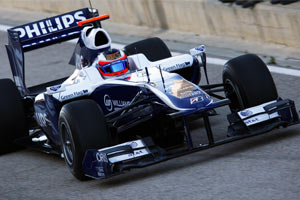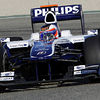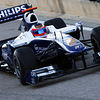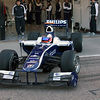Williams FW32 Cosworth

Active: 01-02-2010 - 2010
Team: Williams F1
Team: Frank Williams (TP), Patrick Head (DE), Adam Parr (CEO), Sam Michael (TD), Alex Burns (COO), Toto Wolff (NED), Ed Wood (CD), Jon Tomlinson (CA)
Drivers: Rubens Barrichello (9), Nico Hülkenberg (10), Valeri Bottas (test)
The Williams FW32 is the second clean sheet design for the Williams design team in as many years. The car debuted on track on 1 February at Valencia. It was not officially launched to the public before that.
Ed Wood, the FW32’s Chief Designer reflects, “As race car designers and engineers, we are not exempt from the wider economic climate and of course understand that regulatory stability is necessary to drive down costs, but nothing lights the creative touchpaper better than a new set of rules. Jon Tomlinson, Head of Aerodynamics, adds, “Last year was a case in point; although the subject became fairly controversial, the designers’ and aerodynamicists’ achievement in conceptualising the double-diffuser and proof-testing it against the regulations was intensely satisfying.”
So with a significant change in the rulebook for 2010, driven by the refuelling ban, it is a far more difficult to predict the likely form with any degree of confidence. But not content to be driven by the rules alone, Williams has also focused its design endeavours for the FW32 around a key objective: to maximise the car’s aerodynamic efficiency. Sam Michael explains. “Prior to the 2009 car, the FW31, we tended to struggle with performance variations at different types of circuit.” At some circuits we were competitive, at others nowhere. This is not the platform you want in order to develop a car and take it forward as much of your resource is otherwise channelled into finding consistency. With the FW31 – a car that was not derived from its predecessor - we managed to dial out the car’s bad habits and made a good fist of moving the car forward along a development path at every race.” He continues, “Although little of last season’s car is being taken forward, we are confident that we have pursued a sound design philosophy with the FW32 and this to a large extent has been driven by the pursuit of aerodynamic efficiency.”
The most nakedly apparent changes to the car that reflect this approach are the raised height of the front suspension assemblies and the FW32’s deeper sidepod undercuts. The front suspension design has dramatically improved clean airflow around the front of the car, but the raised suspension mounting points present a greater mechanical challenge to maintain stiffness due to the increased loads these assemblies must bear. Despite this, Michael says, “We have actually found some improvements in this area despite moving the entire assembly far higher. In the design of the front of the car, we also found a good accommodation for Ruben’s left- and right-foot braking style, which traditionally would have been impeded by the steering column, and we managed this without design penalty.”
Naturally the integration of a new engine presents another subset of design challenges, but with experience derived from using the Cosworth powerplant in 2006 and the engine being inherently good to package anyway, Michael was upbeat about the progress that had been made. “In an ideal world, you’d have a long timeframe to make the swap to a new engine. As it was, we cut the decision pretty fine, but I am confident that the positive working relationship with Cosworth has yielded a good outcome. It was quite a straightforward aspect of the design and they are a good and engineering-driven team to work with.”
The change in engine prompted a complete revision of the gearbox, again with aerodynamic efficiency being the key target. “The gearbox represents a pretty significant set of changes,” Sam says, “and it affects everything from the casing to the location of the final drive. The rear suspension has had a makeover, too, guided by the same parameters as the modifications to the front of the car. The goal was to increase aerodynamic efficiency with no loss of suspension performance and, again, the designers have not only met their aerodynamic objectives but have also found gains in the mechanical performance of the suspension.”
As your eye runs along the car’s length, the last visible element is a completely revised rear impact structure. This is part of a constant evolution as teams seek to enhance driver protection. This year’s crash tests include a mandatory increase in frontal protection, a move designed to take account of the greater weight imposed by full-race fuel loads (up to 180kg, in some cases). Interestingly, despite the anticipated change to car dynamics to account for the increased fuel loads, the FW32’s weight distribution is very similar to that of its forebear. “There are two variables at odds with each other here,” says Sam. “The front tyre is now narrower, but the construction of the rear tyre has changed, so we believe that the grip balance front to rear will remain largely the same despite the higher fuel loads.”

The longer wheelbase and the dynamic impact of higher fuel loads (plus their bearing on tyre degradation) have prompted much speculation about race strategies. Michael thinks that it will take four to five races for a pattern to develop, but anticipates that the GP2 Series – an F1 support category in Europe – will provide some of the answers. “In GP2,” he says, “the cars at the back stop earliest because it is in their interest to follow a slightly riskier strategy and this tends to cascade forward to the faster cars. The leading cars will watch the time deltas and choose to pit when they can no longer cover the cars behind them that are now on fresh rubber. This process starts from the rear of the field and shifts forwards. We have different variables in F1, so it might not follow exactly the same process, but it is the only real-world reference point we have at the moment. In the meantime, we are working hard on our simulations.”
Looking back at an intense winter of development, Sam concludes, “It was our aim to ensure stability in our design team. We have now that for the past three years and it is now time for that group to deliver a front-running car. In 2010, we have all the elements in place, not just the chassis team, but engine and drivers, too. All of this means we should be capable of delivering at the front of the field – and that’s what we have to do.”
Specifications
Chassis construction: Monocoque construction fabricated from carbon epoxy and honeycomb composite structure, surpassing FIA impact and strength requirements
Front suspension: Carbon fibre double wishbone arrangement, with composite toelink and pushrod activated springs and anti-roll bar
Rear suspension: Double wishbone and pushrod activated springs and anti-roll bar
Transmission: Williams F1 seven-speed seamless sequential semi-automatic shift plus reverse gear.
Gear selection: electro-hydraulically actuated
Clutch: Carbon multi-plate
Dampers: Williams F1
Wheels: RAYS forged magnesium
Tyres: Bridgestone Potenza, F 325mm wide, R 375mm wide
Brake system: 6 piston callipers all round, carbon discs and pads
Steering: Williams F1 power assisted rack and pinion
Fuel system: Kevlar-reinforced rubber bladder
Electronic systems: FIA standard electronic control unit
Cooling system: Aluminium oil, water, and gearbox radiators
Cockpit: Driver six-point safety harness with 75mm shoulder straps & HANS system,
removable anatomically formed carbon fibre seat covered in Alcantara
Dimensions & weight: Overall width: 1800mm
Engine
Designation: Cosworth 2.4L V8, 90° V angle engine
Valve train: pneumatic
Fuel management and ignition systems: Cosworth
Engine materials: include block and pistons in aluminium, crankshaft in steel billet, connecting rods in titanium





